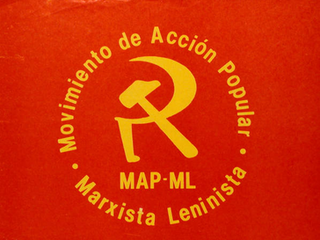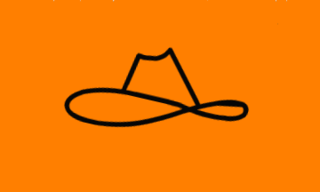Related Research Articles

José Daniel Ortega Saavedra is a Nicaraguan politician and the 58th president of Nicaragua since 2007. Previously, he was leader of Nicaragua from 1979 to 1990, first as Coordinator of the Junta of National Reconstruction from 1979 to 1985, and then as the 54th President from 1985 to 1990. During his first term, he implemented policies to achieve leftist reforms across Nicaragua. In later years, Ortega's left-wing radical politics cooled significantly, leading him to pursue pro-business policies and even rapprochement with the Catholic Church. However, in 2022, Ortega resumed repression of the Church, and has imprisoned prelate Rolando José Álvarez Lagos.

The Sandinista National Liberation Front is a Christian socialist political party in Nicaragua. Its members are called Sandinistas in both English and Spanish. The party is named after Augusto César Sandino, who led the Nicaraguan resistance against the United States occupation of Nicaragua in the 1930s.

The Constitutionalist Liberal Party is a political party in Nicaragua.

The Nicaraguan Revolution began with rising opposition to the Somoza dictatorship in the 1960s and 1970s, the ouster of the dictatorship in 1978–79, and fighting between the government and the Contras from 1981 to 1990. The revolution revealed the country as one of the major proxy war battlegrounds of the Cold War.
This article gives an overview of liberalism in Colombia. It is limited to liberal parties with substantial support, mainly proved by having had a representation in parliament. The sign ⇒ means a reference to another party in that scheme. For inclusion in this scheme it is not necessary for the parties to have labeled themselves as a liberal party.

Herty Lewites Rodríguez was a Nicaraguan politician. He was Mayor of Managua and a candidate for president in the 2006 Nicaraguan general election when he died suddenly.

The Republic of Nicaragua elects on the national level a head of state—the president—and a unicameral legislature. The president of Nicaragua and his or her vice-president are elected on one ballot for a five-year term by the people.

Popular Action Movement - Marxist–Leninist is a Hoxhaist communist party in Nicaragua that surged out of a split from the Sandinista National Liberation Front (FSLN) in the early 1970s. Since 1985 it is officially named the Marxist–Leninist Party of Nicaragua, but the original name MAP-ML is far more known and has been used when participating in elections.

The Social Christian Unity Party is a centre-right political party in Costa Rica.

The Conservative Party was a conservative political party in Nicaragua. Its slogan was "Dios, Orden, Justicia", often depicted on the three sides of a triangle.

National Opposition Union was a Nicaraguan wide-range coalition of opposition parties formed to oppose president Daniel Ortega's Sandinista National Liberation Front (FSLN) in the 1990 election. Its candidate Violeta Chamorro eventually won the race. UNO traced its origins back to the Nicaraguan Democratic Coordinating Group, which was formed in 1982 by different opposition groups. At the time of the election, of the UNO coalition's fourteen political parties, four were considered conservative, seven could be characterised as centrist parties, and three – including Nicaragua's Communists – had traditionally been on the far left of the political spectrum.

General elections were held in Nicaragua on 5 November 2006. The country's voters went to the polls to elect a new President of the Republic and 90 members of the National Assembly. Daniel Ortega of the Sandinista National Liberation Front (FSLN) was elected president with 38% of the vote, defeating Eduardo Montealegre with 28%, José Rizo with 27%, Edmundo Jarquín with 6%, and Edén Pastora with 0.3%. The FSLN also emerged as the largest party in the National Assembly, winning 38 seats.

The Nicaraguan Liberal Alliance is a political coalition in Nicaragua. It was started in 2005 by Eduardo Montealegre and other members of the Constitutional Liberal Party who opposed former President of the country Arnoldo Alemán's continued control of the PLC even after he had been found guilty of misuse of public funds, and was sentenced to 20 years in prison. Montealegre also opposed the political alliance, commonly referred to as 'El Pacto', between Alemán as head of the PLC and Daniel Ortega, head of the Sandinist National Liberation Front.

The Sandinista Renovation Movement is a Nicaraguan political party founded on 21 May 1995. It defines itself as a democratic and progressive party, made of people of all genders, that promotes the construction of a Nicaragua with opportunities, progress, solidarity, democracy, and sovereignty.

The Independent Liberal Party is a Nicaraguan political party, which separated from Somoza's Nationalist Liberal Party (PLN) in 1944 and took part in the probably fraudulent election of 1947, won by Somoza's favored candidate. The PLI participated in the 1984 election, winning 9.6% of vote for President with its candidate Virgilio Godoy. In 1990 it was part of the National Opposition Union (UNO) - a broad alliance of Sandinista regime opponents - with Virgilio Godoy running as the vice-presidential candidate. UNO won the elections with 54% of the vote. The UNO alliance split in 1993, and in the 1996 elections the PLI, under the candidature of Virgilio Godoy, suffered its worst electoral debacle, receiving only 0.32% of the vote. It joined with Enrique Bolaños' PLC for the 2001 elections, and was part of Montealegre's Nicaraguan Liberal Alliance in the 2006 elections.

The Agrarian Labor Party was a Chilean political party supporting the candidacy of Carlos Ibáñez del Campo for the 1952 presidential election. Formed in 1945, it was dissolved in 1958.
In 1979, the Sandinista National Liberation Front (FSLN) overthrew Anastasio Somoza Debayle, ending the Somoza dynasty, and established a revolutionary government in Nicaragua. Following their seizure of power, the Sandinistas ruled the country first as part of a Junta of National Reconstruction. Following the resignation of centrist members from this Junta, the FSLN took exclusive power in March 1981.

General elections were held in Nicaragua on 6 November 2011. The incumbent president Daniel Ortega, won a third term in this election, with a landslide victory.

General elections were held in Nicaragua on 6 November 2016 to elect the President, the National Assembly and members of the Central American Parliament. Incumbent President Daniel Ortega of the Sandinista National Liberation Front (FSLN) was re-elected for a third consecutive term amid charges he and the FSLN used their control of state resources to bypass constitutional term limits and hamstring political rivals. The FSLN benefited from strong economic growth and relatively low levels of crime compared to neighbouring countries.

Luis Fernando Carrión Cruz is Nicaraguan politician. He is a former guerilla and one of the nine commandantes of the Sandinista (FSLN) National Directorate that overthrew the Somoza regime in 1979. Born to a wealthy, politically-connected family, he began college in the United States but returned to Nicaragua, first joining a radical Catholic group then the FSLN. He led the Carlos Roberto Huembes Eastern Front in Chontales during the final offensive of the revolution. He was a government minister and member of the FSLN National Directorate until 1995 when he split with party and became a cofounder of the Sandinista Renovation Movement (MRS).
References
- ↑ "Ethic". Archived from the original on 2012-04-26. Retrieved 2011-12-27.
- ↑ http://www.giga-hamburg.de/dl/download.php?d=/content/ilas/archiv/brennpunkt_la/bpk0121.pdf S. 232